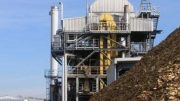 Burning wood to fuel power stations can create as many harmful carbon emissions as burning coal, according to a government report.
Burning wood to fuel power stations can create as many harmful carbon emissions as burning coal, according to a government report.
UK taxpayers subsidise energy firms to burn wood to meet EU renewables targets. But the report from the Department of Energy and Climate Change (DECC) shows sometimes much bigger carbon savings would be achieved by leaving the wood in the forests. This suggests power firms may be winning subsidies for inadvertently making climate change even worse.
The report has caused controversy within DECC as it indicates the initial subsidy rules were much too simplistic. The government has now promised to strengthen the regulations on burning wood, and to make standards mandatory.
Environmentalists applauded the move but said they wanted to see details and a timetable for the new rules. They insisted that the proposed new regulations must be based on the new document.
Whole trees v wood waste
Burning biomass – such as wood – is not a zero-pollution option. It creates greenhouse gases to cut and transport the wood, and when the wood is burned.
But supporters say that so long as the burned vegetation is replaced by new plants to absorb CO2 that should confer a significant advantage over using fossil fuels. And it counts as renewable energy because new trees soak up the CO2 emitted by the burned trees. The DECC report says a key error in the government’s previous calculations was a failure to acknowledge the different types of impact that can be created in different types of forests when wood is removed to burn.
Burning whole logs from natural forests would be counter-productive, the report says, whilst generating power from wood waste that would otherwise be burned at the roadside could provide benefits for the environment overall. DECC stepped up research on the issue after a paper by a US academic showed that burning whole trees would produce more emissions than burning coal, by the time transport emissions are taken into account.
“When we first saw this research we didn’t believe it,” a government source told BBC News. “But we did the calculations and found that we had been wrong.”
‘Complex and disputed’
Under the current rules there is no way of government knowing whether wood is being burned in a way that is beneficial to the climate or not”. He added: “This is really embarrassing for the government – they have finally admitted what we have been saying for a very long time.
“Under the current rules there is no way of government knowing whether wood is being burned in a way that is beneficial to the climate or not.”
The UK’s biggest power station, Drax, is switching half of its boilers from coal to wood pellets in a plan to reduce greenhouse gas emissions. The firm insists that it is using off-cuts of wood that would otherwise be waste. But the issue is complex and disputed. The firm has a wood pellet operations in the USA, which collect thinnings and off-cuts from trees. This is wood deemed appropriate to use in power stations. But there is another wood pellet plant sending biomass to the UK using whole trees from endangered swamp forests.
So the DECC calculator may help government and industry determine exactly what sort of biomass it is useful to burn, but the evidence will be scattered between multiple producers in supply chains thousands of miles away.
The report says there may be enough spare waste wood in America’s forests to supply current UK demand sustainably.
But knock-on effects are hard to calculate across an entire industry.
‘Short-term’ target
What is the effect on soil structure and nutrients of clearing all the waste wood from a felled forest?
What if the price for burnable wood outstrips the price for wood pulp, and forces the USA to import wood from elsewhere to make its paper products?
American researchers wrote to the UK Energy Secretary Ed Davey saying that UK biomass policies were harming wildlife in the USA, and I understand Mr Davey sees biomass burning as a temporary solution to meet short-term carbon reduction targets. The subsidies last until 2027. Policy uncertainty after that date means investors may soon stop building new wood pelleting plants in the USA. This could put a natural brake on the expansion of the trade, which is otherwise expected to expand to as much as 23.5 million tonnes of oven-dried wood a year – a figure environmentalists say is barely credible.
Dorothy Thompson, chief executive of Drax, said: “Sustainability has always been absolutely central to our biomass strategy.
“The academic study by DECC confirms what Drax has always argued – that there is a right way to source biomass and a wrong way.
“We welcome that it confirms the fact that where biomass is sourced sustainably major carbon savings can be delivered.”
She said the main generators in the UK were clubbing together to produce their own tighter rules for biomass. And she urged the UK and the EU to impose tighter standards across the entire industry as soon as possible. Dr Bernie Bulkin, former chair of the Office of Renewable Energy at DECC, said: “This is a careful piece of work that presents many different scenarios for how and where the biomass is grown, how it is transported to the UK, whether it is grown specially for this purpose or is waste, and so on.
“Some of these turn out to be very advantageous from the carbon savings perspective, and some are terrible.
“Some people will undoubtedly pick up on the ‘bad’ scenarios and highlight them. This is a mistake.
“What we need to do now is put in place the systems and processes to make sure we achieve this in the best possible way.”
Roger Harrabin
Originally published by the BBC
24 July 2014






Be the first to comment on "Concerns over carbon emissions from burning wood"